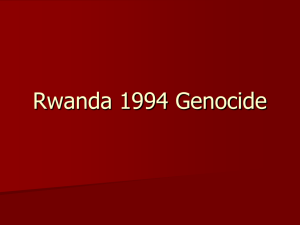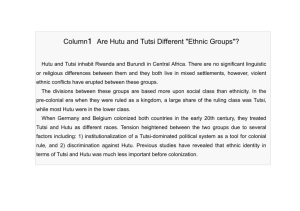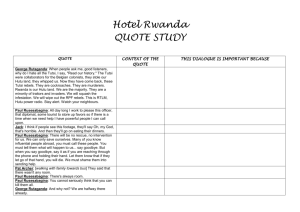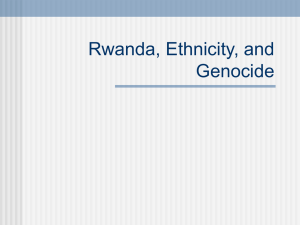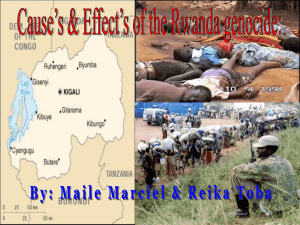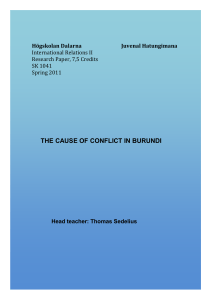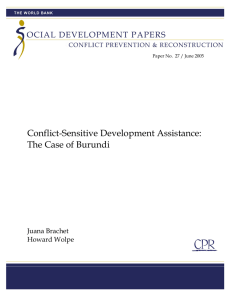Chapter 10 Malthus in Africa: Rwanda's Genocide
advertisement
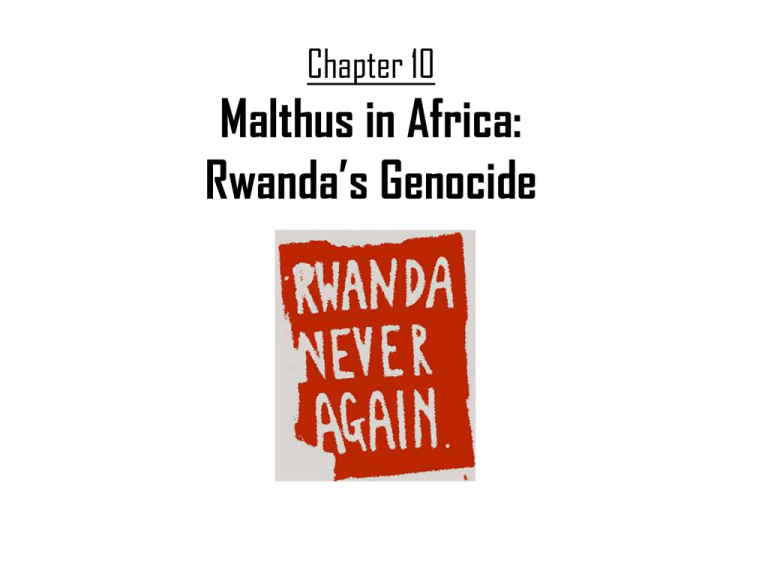
Chapter 10 Malthus in Africa: Rwanda’s Genocide Where is the Rwandan Society? Landlocked between Tanzania, Burundi, Uganda and the Democratic Republic of the Congo. Population Growth • Very densely populated in the early 19th century because of the countries altitude. – Too high for tsetse flies and other carriers of diseases, specifically Malaria. • Moderate rainfall supported agriculture. • The population has been growing at a consistent 3% per year. • The population doubles approximately every 18 to 19 years. Malthusian Theory • Thomas Malthus proposed in 1798 that a societies resources will be replenished arithmetically while humans reproduce exponentially, thus causing an inevitable agricultural shortage. 7000 6000 5000 4000 Population Resources 3000 2000 1000 0 1 2 3 4 5 6 7 Population Density • Along with Burundi, Rwanda is one of the most densely populated countries in Africa. • Nigeria is the third most densely populated country in Africa, but only ¼ the concentration of Rwanda • 1990 – Even after mass killings and exiling, there was an estimated 760 people per square mile. – In comparison, the density of the United Kingdom is 610 people/mile squared and Holland is 950 people/mile squared The Hutu •Make up 85% of the population in Rwanda •The leader of the Hutu government was Habyarimana •Considered to have less power than the Tutsi during the European colonialism period •Shared the same language and culture as the Tutsi •Major population loss during the genocide in Rwanda •Main economic role was being a farmer •Carried identity cards saying they were Hutu The Tutsi • Superior to the Hutu during the European colonization period • Referred to as “Cockroaches” by the Hutu • 800,000 Tutsi people had been killed within a span of 6 weeks • Make-up 15% of the total population in Rwanda Violence •The Hutu were supplied with weapons from businessmen close to Habyarimana •They trained their militias, imported weapons, and prepared to attack the Tutsi •President Habyarimana’s plane was shot down on April 6,1994; in the plane also was the Hutu president from Burundi •Major massacres took place when the Hutu organized to kill the Tutsi. •The Hutu extremist government organized the killings while the Hutu civilians carried out the orders Relations with Neighboring Countries • Had a close relationship with Burundi, shared same Hutu and Tutsi culture • Both became independent around 1950’s • Refugees escaped from Rwanda to Burundi • President of Rwanda Hutu Habyarimana and Burundi’s Hutu president were both murdered. • Burundi and Rwanda suffered Ethnic violence French/U.S. involvement • The U.S./French governments and the U.N. did not get involved with the violence that was going on in Rwanda • The U.S., French, and the U.N. all referred to the situation as “chaos”, “a confusing situation”, and “Tribal Conflict” Fights over land- Family fights • There was a lot of tension between poorer families because land was scarce. • Families were getting into confrontation within themselves. • One of the main problems was that the big land owners had money while the small land owners were desperate for money. • The rich bought land from the poor and kept expanding and the poor kept selling and got smaller. 5 Point Analysis • Environmental Damage – Lack of farm land lead to farming on hillsides, which in turn created a substantial soil erosion problem. – Rwandan farmers do not find it uncommon to have entire farms washed away overnight. -Deforestation led to the drying up of streams and irregular rainfall. • Hostile Neighbors – Rwanda’s issues were mostly because of a civil war, not because of neighboring countries. However, the genocide spread into other countries as well (Burundi). • Lack of support – The US, French and U.N. all avoided the genocide situation. – The Congo and Tanzania accepted refugees during the conflict, but did not intervene in the fighting. • Climate change – Reduced rain fall, drought and global warming. • Societies reaction – It is evident that the “genocide” was not merely a racial or tribal conflict. – In many communities, there were very few Tutsi and mass killings still took place. – The death toll was around 11% of the population, Tutsi only comprised around 5% of the population. – This illustrates that Rwanda's reaction to their collapse was chaotic unorganized.
